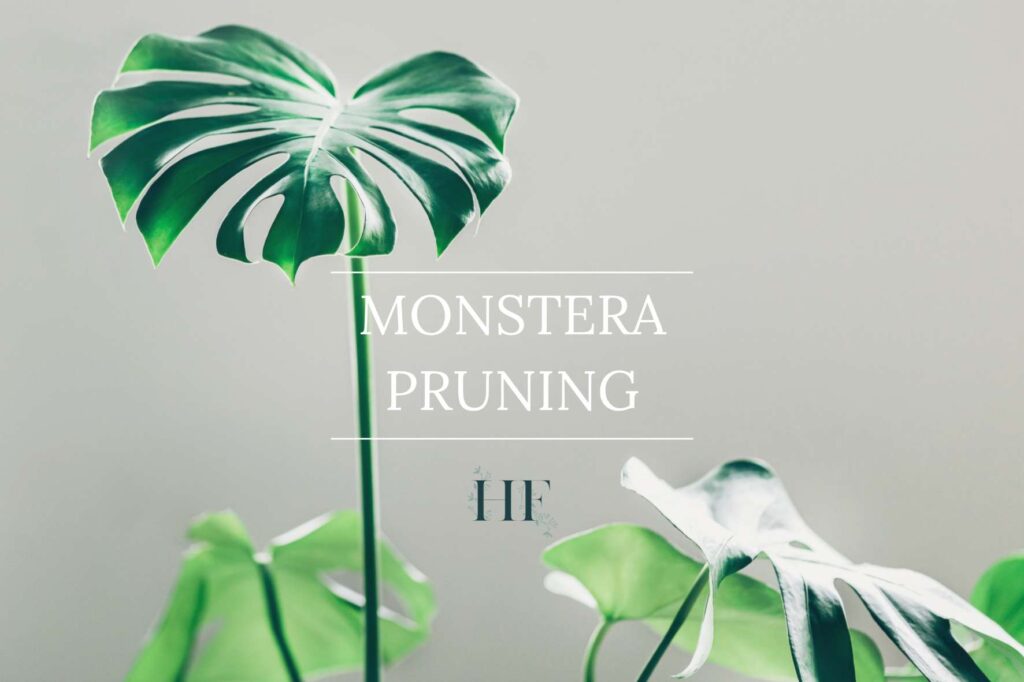Monsteras are mostly recognized for their striking split-leaf foliage, but their ability to become enormous is also well-known.
With that much rapid growth, Monsteras can get too big for your living spaces and eventually you might have the need to cut them back. You may be wondering how, when and why you should prune your Monstera.
Let’s get into the details.
Monstera Pruning
Monstera plants need regular pruning to encourage new growth and stay healthy all year round. Pruning should be done in early spring before the Monstera enters its growing season. When pruning, you can use cuttings with nodes to propagate your Monstera too.
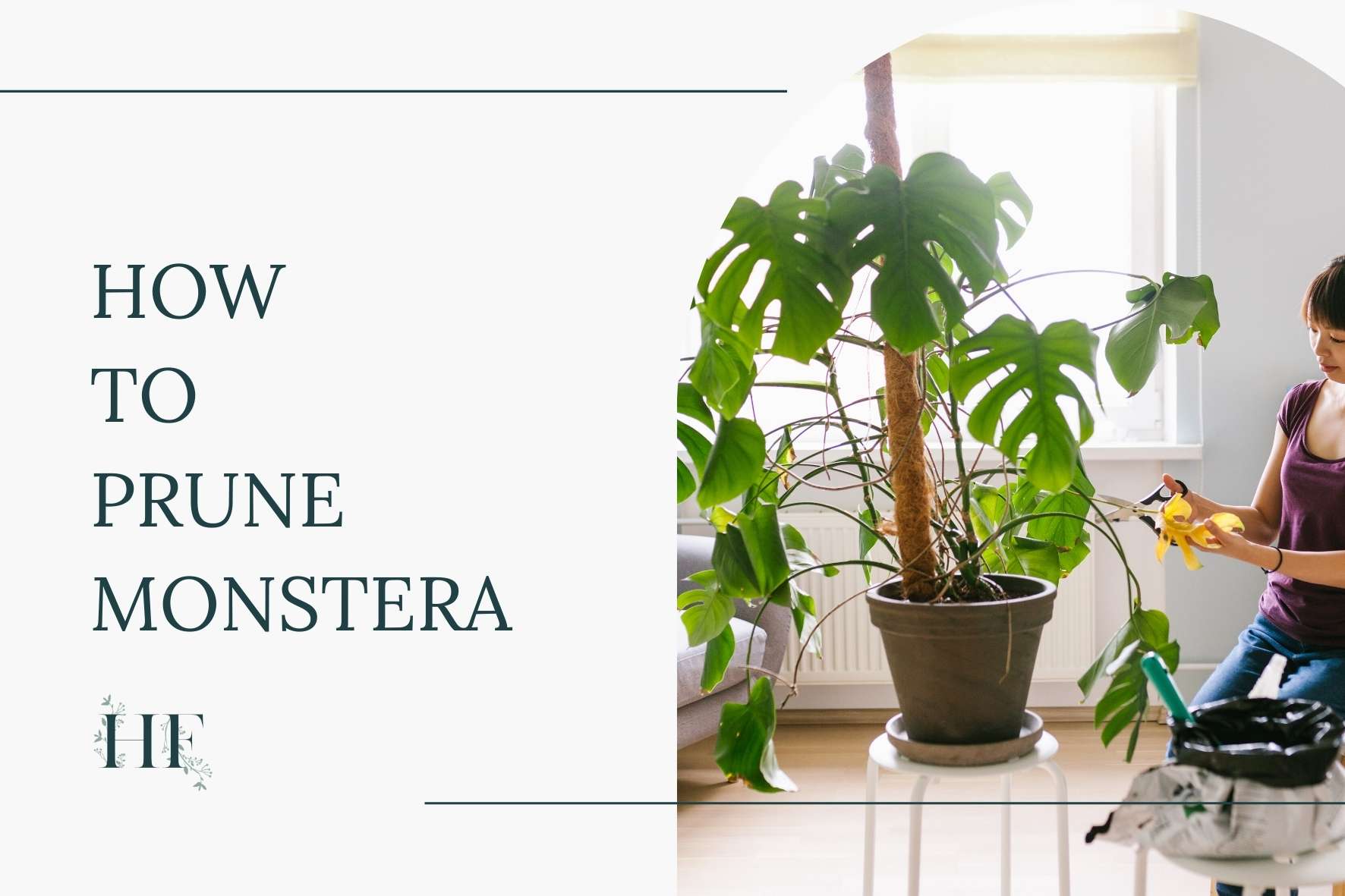
How to Prune Monstera
How you prune your Monstera plant will depend on the reason behind it. Pruning off a few dead leaves is different to trying to trim down an overgrown plant. Likewise, if you are pruning with the goal of propagating your Monstera, you will need to take a bit more care.
I will address each scenario further down this article. For now, let’s have a look at the tools you will be using and how to go about pruning your Monstera.
What you will need:
- Sharp gardening shears: I recommend gardening shears since they ensure that you will make a clean cut, instead of crushing or bruising the stem. Also, they do well with larger, mature stems. Regardless if you use shears, scissors or a gardening knife, your tool needs to be sharp (to avoid damaging the plant) and clean (to avoid transferring any disease or fungus). You can clean them using dish soap or rubbing alcohol.
- Gardening gloves: Since all parts of the Monstera are toxic due to their needle-like insoluble calcium oxalates, you will want to use gloves to prevent skin irritation. Avoid touching your face when handling Monsteras. But if do get some sap on your skin, wash it with soap and warm water.
Here are the basic steps to prune a Monstera:
1) Identify The Reason To Prune
Depending on the size and condition of your Monstera, pruning it back may be as easy as cutting off a few stems or it might need more consideration.
1.1) Pruning Yellow or Dying Leaves
As your Monstera plant grows and matures, older leaves will turn yellow and die naturally. This isn’t anything to be concerned about, it’s part of a Monstera’s life cycle.
If your plant isn’t very old or is suddenly showing a lot of yellowing across the plant, this may indicate an issue like overwatering or root rot.
In order to keep your Monstera plant healthy, it is important to prune off old and yellowed leaves regularly.
To prune yellow or dying leaves, cut as close to where they are attached to the stem as possible, without cutting the main stem or vine.
Insider Tip: Be careful when pruning close to the node. Cutting or damaging the stem or node can weaken the plant, making it more susceptible to damage from pests or diseases.
Once trimmed, you can discard these leaves in the trash or compost bin as they cannot be rooted as a new plant since they don’t have a node. Leaves that don’t look healthy shouldn’t be used to propagate any cuttings.
Lastly, some people like to cut the scorched brown tips of Monstera leaves (due to sunburn) by just trimming the brown part, not the whole leaf. Personally, I prefer not to trim brown tips since doing so is not necessary to maintain a healthy plant.
1.2) Pruning Diseased Parts
If your Monstera shows signs of disease or damage by pests, cut any diseased stems or aerial roots.
Depending on what part (leaf, aerial root or lateral root) you are pruning, follow the specific instructions for it.
After pruning, you’ll want to discard these leaves in the trash since the disease can stay alive and spread if you compost them.
1.3) Pruning to Reshape Overgrown Monstera
Monsteras grow rapidly and can become unruly if they are left to their own devices. Lateral vines can take a lot of space and may even become disruptive.
You can shape your Monstera plant by selectively pruning stems and vines. Sometimes you will want to trim off vines that have grown unruly to maintain the overall shape of the plant. Other times, you may want to encourage new growth in a particular part of the plant.
However, removing too much growth at once can be detrimental to your Monstera and cause shock that seriously damages your plant and stunts its growth. So, avoid cutting more than 25% of the stems at any given time.
There are a few scenarios to consider when shaping a Monstera plant.
To keep an overgrown Monstera Deliciosa in shape, you can prune wayward vines and direct new growth in the direction you prefer:
- Identify the vine you want to prune.
- Follow that vine back to the main stem.
- If you make a clean cut close to the main stem, leaving a node, it will encourage new growth along the vine.
- However, if you cut above the node, you will limit the growth of that particular vine.
These cuttings can also be propagated, but you will need to trim them again a few inches below a node.
If your plant is very large, you may want to consider cutting beneath nodes with a significant amount of growth. Look for stems with multiple leaves and try to clip those areas. This will allow you to make more progress with fewer cuts.
On the other hand, if your plant isn’t too large or doesn’t require much pruning, a few selective cuts made as close to the parent stem as possible is sufficient to keep your Monstera from growing wild.
If your Monstera plant lacks the lush foliage you desire, you can prune it to encourage new growth and create a more compact plant.
When pruning a Monstera to encourage new growth, determine where you would like new growth to appear, select a stem, locate the node and make a clean cut just above the node. New foliage will sprout along the vine.
For a shorter and fuller Monstera plant, trim the dominant stems. But, for a more expansive Monstera, cut some of the lateral leggy stems. Trim them close to the centre of the plant.
When pruning, you want to go for a staggered look, so that new growth is all over the plant. This means not cutting at the same level or height.
Read also: Monstera Growth Rate, Life Cycle and Lifespan Facts and Tips, which includes 7 tips to encourage your Monstera plant to grow faster.
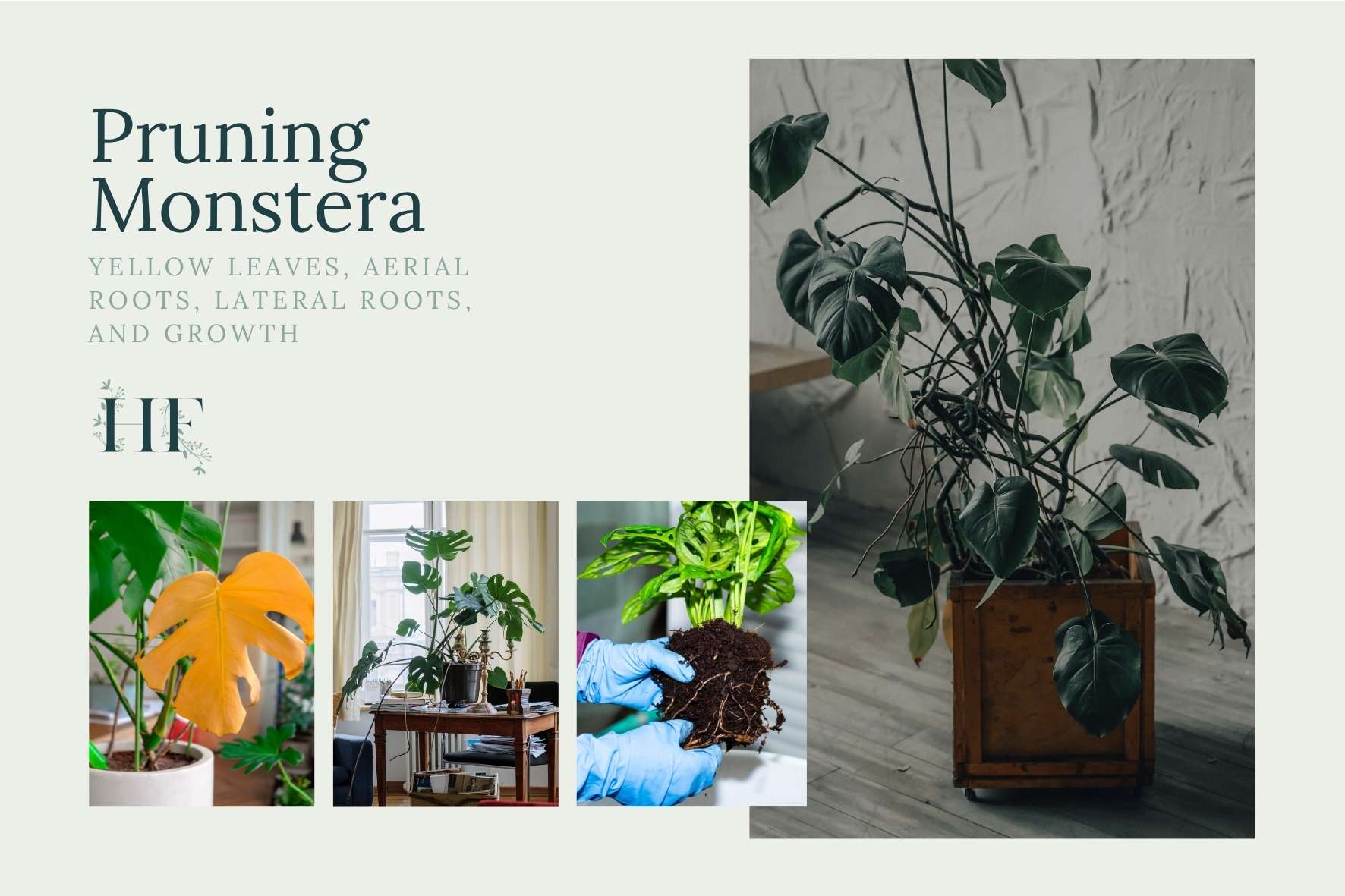
1.4) Pruning Aerial Roots
Aerial roots are roots that develop above ground.
An overgrown Monstera will also have very long aerial roots. These can try to climb up your walls or furniture, which can damage paint and finishes. So, if your monstera’s aerial roots are getting out of control (growing too big and reaching everywhere), you have two options: pruning or supporting them by guiding them into a trellis or moss pole.
Trimming the aerial roots of your Monstera won’t harm your plant. When pruning, it’s important that you remove the entire root and not just part of it. Trim these aerial roots as close to the stem or node as possible.
Also, you should note that pruning can encourage aerial root growth, resulting in multiple roots popping up where only one was before.
For instance, if the aerial roots are pilling on the floor, you can prune them so the roots are no longer touching the floor.
For more information on aerial roots, click here.
1.5) Pruning Lateral or Underground Roots
Lateral or underground roots are the ones that grow inside the soil of a potted Monstera.
The main reason to prune lateral or underground roots is to slow down the growth of giant Monstera, keeping them from growing bigger than they are.
When pruning roots, remove your Monstera plant from the pot. You will see one main root with smaller lateral roots growing off it. The goal is to cut back the lateral roots by one-third and to leave the main root intact.
This is a good time to trim away any discoloured or damaged roots too.
1.6) Pruning to Propagate Monstera
Monsteras can be propagated with stem cuttings placed in soil or water, among other propagation methods.
But for the propagation to be successful, the Monstera cutting needs to have at least one node. That means that you need to be selective when making node cuttings. You can take a top cutting, a mid cutting or a stem cutting (also known as node cutting, or wet sticks).
When pruning for Monstera propagation, make a clean cut a few inches below the node.
For the fastest results that also guarantee a higher rate of success, many plant experts recommend choosing a stem with a few nodes, an aerial root, and 2 to 3 healthy leaves.
If you are planning on propagating cuttings, you can check the blog post I wrote about Monstera propagation in soil, water and much more!
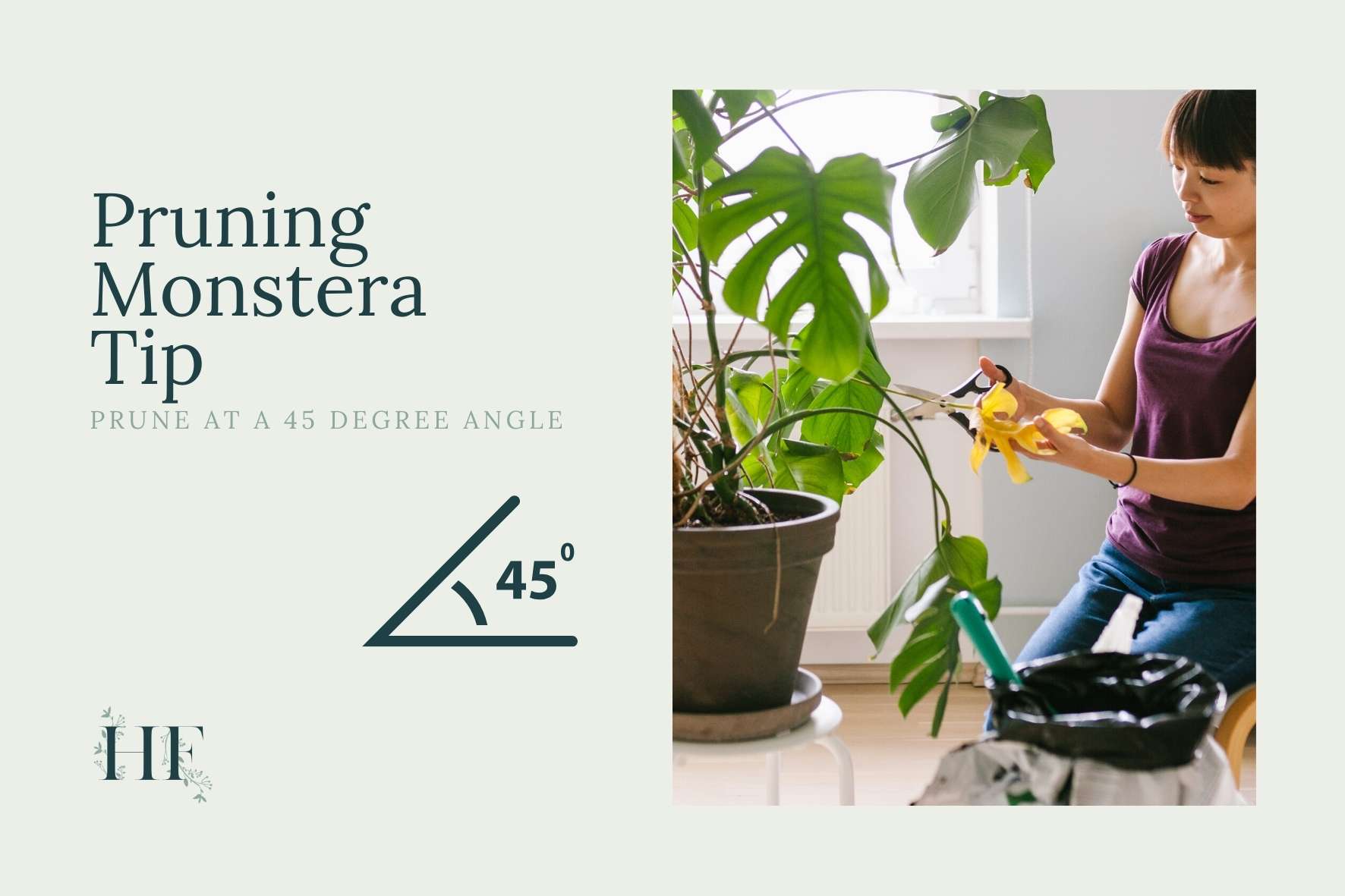
2) Make a Clean Cut at a 45-Degree Angle
You want to make sure the stem doesn’t get compressed or damaged while you are pruning.
When you prune your Monstera, make a clean cut on the stem at a good 45-degree angle. Using a pair of clean (sanitized) and sharp shears, cut just above the node when pruning yellow or dying leaves. Only when pruning with the intention to propagate the cutting should you trim a few inches below the node.
Monstera nodes are bulging, this part of the stem may be thicker than the internodes, and have light green circular rings, making them easy to identify from the rest of the stem.
Insider Tip: If there’s a leaf stem splitting off from the main stem (an ‘intersection’ of two stems), there will always be a node just below that growth. You can also find a node where an aerial root is growing.
If you are still a bit unsure of what a node is and how to locate one, I wrote an entire blog post dedicated to this subject. For more information on Monstera nodes, click here.
Lastly, when pruning, it’s best not to cut away more than 25% of the stems at any given time. It may weaken your Monstera plant.
3) Either Discard What You Cut or Propagate the Appropriate Monstera Cuttings
If you haven’t pruned your Monstera plant with the intention of propagating the cuts, then feel free to dispose of what you cut. If the leaves and stems have no disease, you can compost them.
However, if you are planning on propagating a cutting, you might want to start straight away.
Monstera Pruning Questions
Now that you are clear on the how-to part, let’s address other questions that you might get when pruning your Monstera.
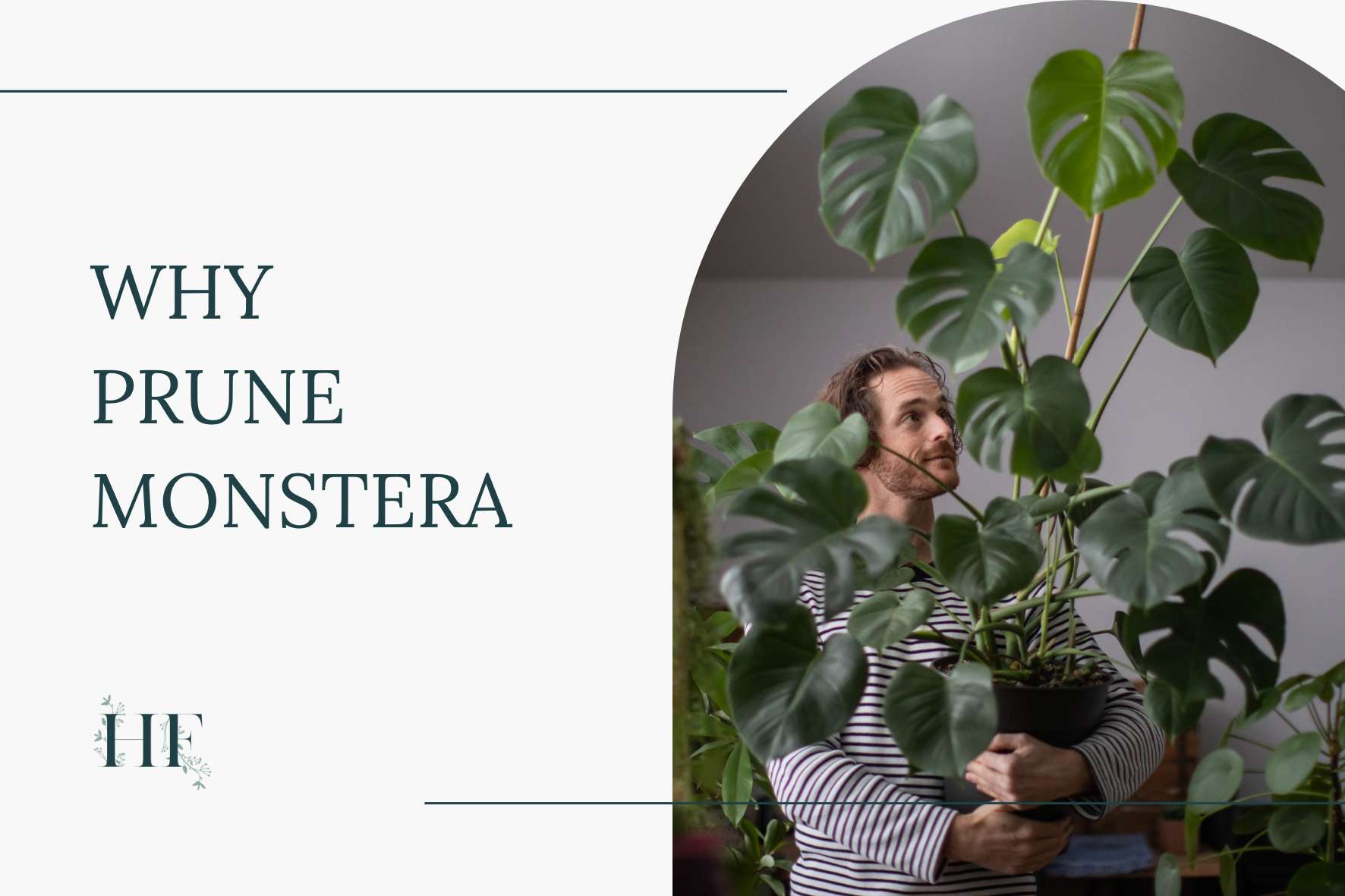
Why Prune Monstera
Should I cut back my Monstera?
If you are still a bit hesitant about pruning your Monstera, let’s see how a gentle trim can benefit your plant.
Besides encouraging growth in the newly-trimmed areas, pruning is vital to maintaining the overall health of your plant. Monsteras grow very quickly, so pruning is essential, especially when kept indoors.
Also, older leaves will turn yellow and eventually die. Cutting off old growth is an effective way to promote the growth of healthy new foliage.
Pruning is also important if you’re concerned about your Monstera outgrowing your living space or becoming unruly since it’s an effective way to control its growth. Regular pruning can keep your plant small enough to be manageable without harming it.
The main reasons why pruning a Monstera is beneficial for the plant include:
1) Getting Rid of Damaged, Yellowing or Dying leaves
These leaves don’t contribute to the plant since they will not perform photosynthesis, yet they take energy away from the Monstera.
When removing them, the plant will focus its energy on new growth, and it will be healthier.
2) Keeping Diseases and Pest at Bay
If your Monstera plant has diseased leaves or is suffering from a pest, pruning off the affected areas will prevent the spread. But first, isolate the infected plant (put it away from your other houseplants).
Pruning may not work for all pests and diseases, primarily if they have spread. Most often than not, you will need to apply a fungicide to treat the disease or kill the pest.
3) Allowing Light Penetration and Air Circulation
Although a bushy Monstera looks great, a very tangled and bushy plant may prevent light from penetrating to inner leaves or even reaching areas not facing the window (or light source).
As a result, due to lack of light, you can end up with a leggy Monstera. This means, your Swiss Cheese Plant will have longer and thinner stems without the full, large leaves.
Also, being too tangled can affect your Monstera’s air circulation, providing a perfect hiding place for pests.
So, in this case, removing a few leaves can improve both light penetration and air circulation.
4) Managing Growth and Reshaping
Another reason to prune Monstera is to manage its size and shape.
Monstera plants can still get very big indoors. For instance, a Monstera Deliciosa can grow as big as 8 to 15 feet high (2.4 to 4.6 metres high) and over 8 feet wide (2.4 metres wide).
Besides pruning, you can also train your Monstera to help control its shape. However, if it becomes too large and outgrows your living space, you will probably want to cut it back.
5) Encouraging Fuller Growth
If you have a leggy Monstera plant, pruning may help encourage fuller growth. Monsteras grow new stems from the node just beneath the cutting point.
So, if you want your Monstera to spread, cut lateral branches and if you want your Monstera taller, target the dominant stem (the stems that are growing upward).
6) Propagating The Parent Monstera to Create New Plants
The final reason why you may prune a Monstera is to get a stem cutting for propagation.
Remember, you cannot propagate Monstera without a node. So, select a healthy and mature node and decide if you want leaves and aerial roots to maximize the success changes.
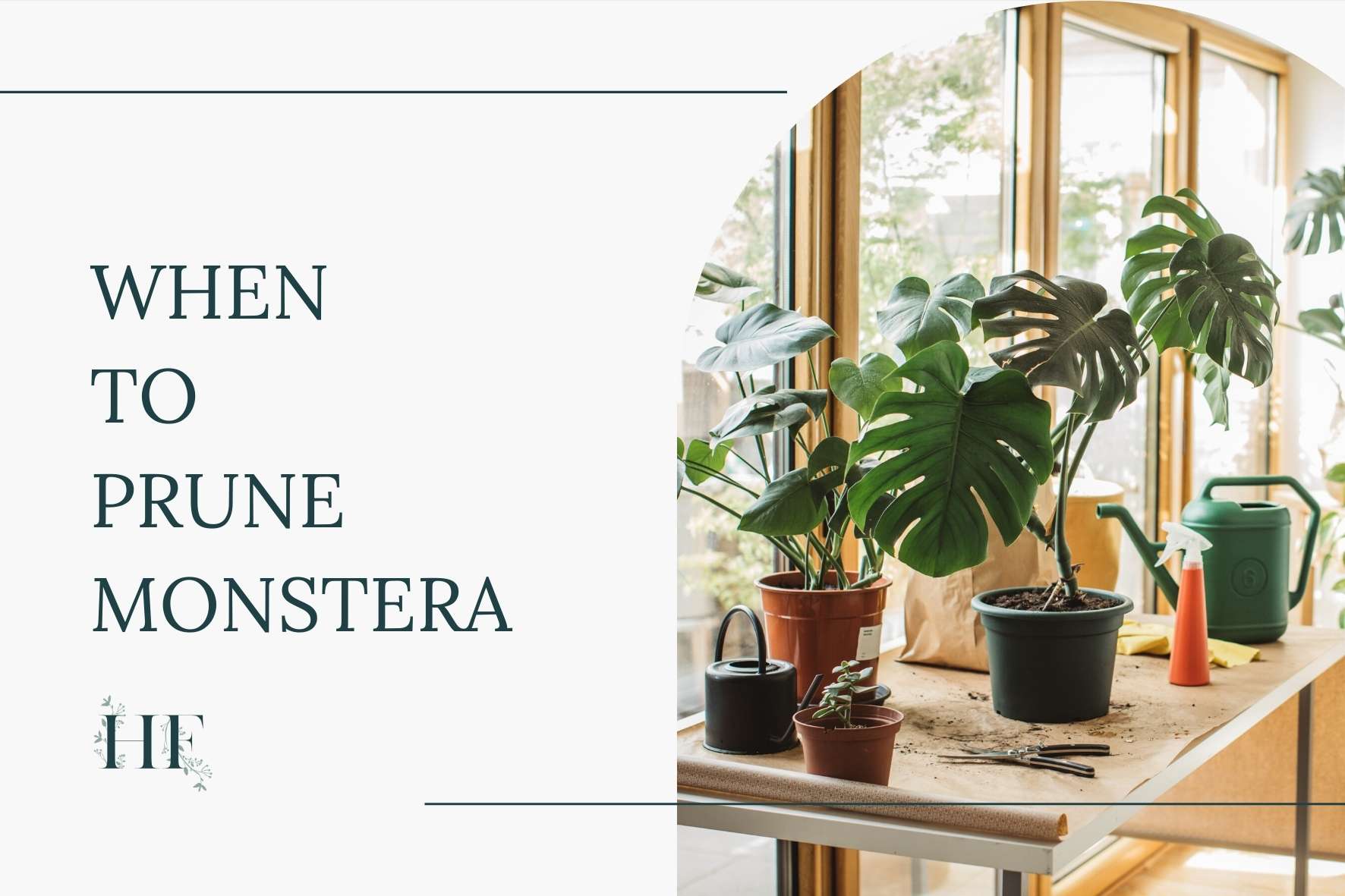
When to Prune Monstera
Most plants, the Monstera genus included, experience growth spurts in spring and summer. So, generally, the best time to prune any houseplant is before it enters its growing season and is still dormant.
The best time to prune a Monstera is in early spring just before its growing season begins. This ensures your plant will have the resources it needs to recover from any stress or damage from pruning and be ready to send out a flush of new growth.
Most plants begin coming out of this dormant period in the early spring when the days start to get longer, and the temperatures begin to rise. Plants are preparing to enter a period of high growth activity, and they will have an easier time repairing the damage from being pruned.
The worst time to prune a Monstera is autumn and winter since it’s when it will enter dormancy. There is simply inadequate sunlight for photosynthesis to fuel growth and repair damage caused by pruning.
Plants enter a dormant period in the winter because the lack of sunlight slows down photosynthesis; Monstera plants enter dormancy in the fall and winter. The plant doesn’t stop growing altogether, but growth is minimal throughout the fall and winter.
How Often Should Monstera be Pruned?
The frequency of pruning will depend on the age, size and growth rate of your Monstera. Typically, a young or small Monstera will need pruning once a year. A more mature and fuller plant may need to be trimmed monthly to maintain an even shape.
Also, some varieties like Monstera Adansonii and Monstera Siltepecana (among others) grow at a much faster rate than the more common Monstera Deliciosa. So, you might need to prune them monthly.
Where to Cut Monstera Leaves
Where you cut your Monstera depends on why you are pruning it.
As discussed before, when pruning yellow or dying leaves, cut as close to where they are attached to the stem as possible, just above the main stem and node.
However, if you intend to use the pruned cuttings from your Monstera for propagation, the cutting needs to have at least one node. In this case, cut the stem a few inches below a node.
If you are pruning roots to control the size and growth of your Monstera plant, make sure you only cut the lateral roots by one-third and leave the main root (which is thicker and sturdier) intact.
Finally, to trim aerial roots, remove the whole air root by cutting as close to the stem or node as possible.
Should I Cut off Small Monstera Leaves?
You can cut off small Monstera leaves, especially if you are concerned about them taking too much of your plant’s resources and want to encourage growth.
However, small leaves on your Monstera plant usually signal that its growing needs are not being met and so pruning your Monstera’s small leaves will not solve the underlying problems causing this.
Instead, you can try a change in location to increase indirect sun exposure, and follow species-appropriate care (i.e., watering when needed, feeding during the growing season, etc.)
Should You Prune a Leggy Monstera Plant?
Legginess occurs when your Monstera plant is not getting enough light to perform photosynthesis properly and produce new healthy growth.
Therefore, to fix a leggy Monstera, check that the light hitting your Monsteras leaves is bright enough to cast a fuzzy shadow (but avoid direct sunlight).
Apart from providing adequate lighting, you can also prune a leggy Monstera to encourage new growth and improve the appearance of the plant. When trimming a leggy Monstera, cut the stem just above a node.
Here’s how to prune a leggy Monstera:
- Gather your tools: gardening shears and gloves.
- Before pruning, clean your shears with soap or white vinegar to prevent bacteria and illness from spreading.
- Identify the leggy stems that you want to trim and locate the node from where you will make the cut.
- Then, prune the stem at a 45-degree angle just above the node.
- After every cut, take a couple of steps back to assess if you are closer to your desired shape. However, it’s best not to cut away more than 25% of the stems at any given time since it can weaken your Monstera plant.
- Decide if you want to propagate or discard the cuttings. If you decide to propagate, you will need to trim the cuttings again a few inches below a node. Check this guide with all you need to know about Montera propagation.
Since pruning a leggy Monstera won’t fix the legginess, check How Do I Fix a Leggy Monstera? 5 Proven Solutions blog post to find out how to fix the problem and encourage healthy growth.
For this and other issues that you might encounter check the Monstera Problems blog post.

